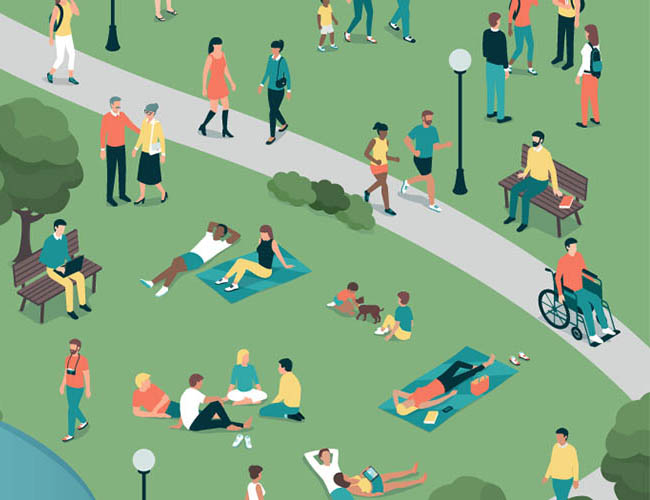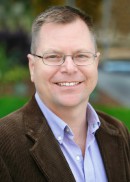Breadcrumb
Health for All
By Debra Venzke
Published on June 27, 2019
 The college equips students, practitioners, and communities with knowledge and skills to advance health equity.
The college equips students, practitioners, and communities with knowledge and skills to advance health equity.
At first glance, the basic premise of health equity seems simple: ensure that everyone has opportunities to attain their highest level of health. But dig a little deeper and you’ll soon unearth a complex tangle of barriers that hinder people and communities from achieving their full health potential.
Paul Gilbert, CPH assistant professor of community and behavioral health, explains health equity to his students as “the idea that some groups are disadvantaged, marginalized, or held down, and other groups have the wind at their back. We want to try and equalize that, so one group isn’t over-privileged and the other group isn’t under-resourced or disadvantaged in other ways.”
“By definition, health inequities are preventable, as they are the result of structural, social, economic, political, and commercial factors that affect some groups more than others,” adds Rima Afifi, CPH professor and interim head of community and behavioral health. “Since they are preventable, they are unfair and unjust.”
The roots of this injustice run deep, as the American Public Health Association explains: “Inequities often stem from structural racism or the historical disenfranchisement and discrimination of particular marginalized groups, including racial and ethnic minorities, low-income populations, and members of the LGBTQ community. These groups have historically been withheld from obtaining resources that are needed to be healthy, and are disproportionately exposed to a combination of health risks such as poverty, violence, poor neighborhood conditions, and environmental health hazards.”
The Costs of Inequity

Not surprisingly, health inequities lead to health disparities. Gilbert points to data on breast cancer mortality in the U.S. to illustrate one example.
“More white women are diagnosed with breast cancer than black women, yet more black women die from the disease,” he explains. “The thinking is that white women are getting screened earlier, so cancer is getting caught, treated, and cured, whereas black women get screened later, the disease is more severe, and it’s harder to cure.
“We need to work backwards and ask why that’s happening,” Gilbert continues. “Is it the environment of the neighborhoods black women live in? Is it the quality of the clinics they go to? We need to look at which groups are historically privileged and which are disadvantaged and how that plays out.”
Health disparities will cost the U.S. an estimated $126 billion in excess medical costs and lost productivity in 2020, the National Urban League Policy Institute estimates. But there are other costs.
“In an interconnected world, for every person whose critical contributions are not maximized, we all suffer,” explains Afifi. “The person who experiences inequity and is not able to fully contribute might have discovered the cure for cancer or figured out how to save the bees. Achieving health equity ensures that we thrive and flourish together, that we all reach our greatest possible potential as a community.”
Advancing Health Equity
The College of Public Health threads health equity into its coursework, research, student learning experiences, and programming. Two prominent guest speakers who visited the college this spring included Bernard J. Tyson, chairman and CEO of Kaiser Permanente, who delivered the Hansen Distinguished Lecture, and Mona Hanna-Attisha, a pediatrician who helped expose the Flint water crisis. Both discussed health inequities and steps for advancing health for all.

For students, faculty, and staff who want to dive deeper into the topic, the Health Equity Advancement Lab (HEAL) is a group based in the college that provides opportunities to learn about and discuss health equity frameworks and principles. Members meet monthly and can participate in a journal club or work with a team on a poster or case study to present at the annual Science of Health Equity Summit. HEAL also provides technical assistance for community-engaged research for community and academic partners.
HEAL member Sefonobong Obot, a CPH alumna (18MPH) who now works as a research assistant in the college, found that her awareness and interest in health equity developed over time based on personal and educational experiences.
“Growing up in Chicago, I think I’ve always been interested in why individuals and groups have differences in access to resources,” she says. “As I got older, it was harder to not see that this idea of ‘access to resources’ also played a big role in how healthy someone was.”
Obot says she’s encouraged that so many faculty, staff, and students are interested in health equity. “It makes me feel, as a staff member, that I can ask about including or applying more equity-based practices in the creation, design, and implementation of research projects.”
Gaining a Global View

To give students an international perspective on health equity, Afifi and Gilbert co-taught a new class this spring. The course “Global Health Equity” used video conferencing technology to simultaneously connect the University of Iowa with partnering universities in Beirut, Lebanon; Quito, Ecuador; and Victoria, Canada.
The course introduced students to the foundational concepts of equity and disparity, “but the way they play out in different countries is very different,” Gilbert says. “Students learned what the most important drivers of disparity are in different contexts, whether it’s religion, politics, refugee movement, or the status of indigenous peoples.”
In addition to lectures and class activities, students worked in small groups to create a Photo Voice project illustrating a health equity issue at their site and reflected on their positionality and privilege in relation to that issue.
“We had an incredible group of students this semester, students committed to understanding their privilege, reflecting deeply on systems of power and oppression, questioning realities, and making change,” Afifi says. “I hope that students gain greater insight into the social, structural, and political aspects of inequity and see the similarities and differences of how inequities play out across countries. I also hope they leave feeling empowered with strategies that they can use in their careers as public health change agents.”
Working with Communities
Another key to advancing health equity is research that identifies, measures, and evaluates progress in reducing health disparities. A number of centers, programs, and projects based in the college are conducting work around health disparities that affect a variety of populations, including rural residents, agricultural workers, immigrant communities, and LGBTQ Iowans.
The college also is home to three centers that address substance abuse and related health disparities in Native American and Alaskan Native communities. The trio of centers — the National American Indian/Alaska Native Addiction Technology Transfer Center (TTC), the Tribal Affairs TTC, and the Tribal Affairs Prevention TTC — recently received funding totaling $9.5 million over five years from the U.S. Department of Health and Human Services’ Substance Abuse and Mental Health Services Administration to expand their work.
The national centers work in partnership with Native American and Alaskan Native communities in Iowa and around the country, providing technical support for the implementation of culturally relevant substance abuse treatment and counseling. The centers, directed by Anne Helene Skinstad, CPH clinical professor of community and behavioral health, support Native professionals who work with clients struggling with substance use and other behavioral health conditions. The centers also conduct conferences and leadership forums for tribal leaders who are working to reduce addiction in their communities.
The Role of Public Health
To advance health equity, factors that influence health — education, income, housing, food access, health care, transportation, discrimination, and others — need to be addressed across a range of disciplines and organizations. Public health is a vital partner in moving these efforts forward.
“The field of public health needs to continue to take an evidence-based approach, in partnership with affected communities, to highlight disparities, inequities, and the structural and political determinants that cause them,” says Afifi. “Public health also needs to continue to promote inclusion and diversity, and to craft safe, welcoming spaces for dialogue, support, and healing. And we need to continue to work collaboratively with many stakeholders and across sectors to identify solutions that work to ensure equity.”
This story originally appeared in the spring 2019 issue of InSight.